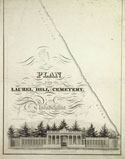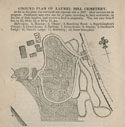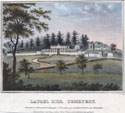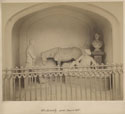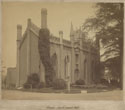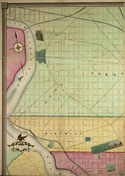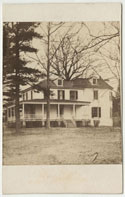Execution and Expansion
Laurel Hill’s managers ultimately settled on Scottish émigré architect John Notman (1810-1865) as their principal designer. Still identifying himself as a carpenter at this time, Notman edged out better-known candidates on a project that helped launch his career. Yet the cemetery’s design remained a work in progress, and a collaborative one at that. Notman and his employers borrowed ideas from his competitors. Smith oversaw the site’s planting, and important aspects of the ground plan were worked out by surveyor Philip M. Price.
The cemetery received its first burial in October of 1836. Three years later, nearly half of the 800 original lots had been claimed. As sales increased in the following decade, Smith and his colleagues realized they were running out of room. However, since the adjacent Fairy Hill estate was unavailable, the managers established a separate annex to the south. Not until the mid 1860s would North and South Laurel Hill Cemeteries be joined.
John Hammond. Plan of the Laurel Hill Cemetery, near Philadelphia (ca. 1845).
Responsibility for subdividing the original 20-acre parcel fell largely to Philip M. Price (1802-1870). A veteran surveyor of urban real estate – he laid out much of Philadelphia's Spring Garden district – he may fairly be credited as an author of Laurel Hill's plan. Like its local, grid-based predecessors, the cemetery was compact. Indeed, a careful observer might have noticed a familiar pattern: lots backed up to each other in double rows, the recipe for a standard city block.
Plan for Laurel Hill Cemetery in Statues of Old Mortality and His Pony, and of Sir Walter Scott (1838). Laurel Hill Cemetery.
John Caspar Wild, artist. Laurel Hill Cemetery, Philadelphia, (ca. 1838). From the collection of David Doret.
This handsome rendering likely served as Wild’s study for the lithograph that appeared as plate 20 in his Views of Philadelphia and its Vicinity, published in 1838, and subsequently reissued [see 4.07b]. Larger and more bucolic than the published version, it is in some respects less accurate; (note, for instance, the omission of lancet windows from the right corner tower). However, the depictions of the Sims mansion, immediately to the right of the entrance, and of the rectangular planting beds in the foreground supply details missing in all other known views.
John Caspar Wild, lithographer. Laurel Hill Cemetery, Philadelphia. Philadelphia: J. T. Bowen, 1848. Originally issued in 1838.
Screens of evergreens on Laurel Hill’s borders enhanced the site’s sense of seclusion. According to horticulturists and moralists, such trees befitted a rural cemetery because they suggested eternal life. Joseph Sims’s soon-to-be-demolished villa peeks through an opening to the right of the gatehouse.
W. & F. Langenheim, photographer. Entrance to Laurel Hill Cemetery, Phila. (ca. 1860). Gift of John A. McAllister.
With assistance from Thomas U. Walter, John Notman designed the triumphal arch that served as Laurel Hill's public face (see also Hammond engraving above). A vaulted passageway separated two caretakers' lodges and provided a dramatic approach to Thom's sculpture group.
Old Mortality, North Laurel Hill. Laurel Hill Cemetery.
In Sir Walter Scott's tale, Old Mortality, the eponymous hero travels the Scottish countryside on horseback, preserving the memories of Presbyterian martyrs by re-carving the inscriptions on their gravestones. Connecting this mission with their own, Laurel Hill's founders bought these sculptures of horse, recumbent rider, and author, when their maker, James Thom, came to town. (The bust is a later addition, depicting Thom himself).
David Kennedy, artist. Cottage & Office at North Laurel Hill Cemetery (1881). The Historical Society of Pennsylvania.
The original Superintendent’s Cottage had an Oriental appearance but was based on English suburban house types of the day. Designed by John Notman, it likely flattered the tastes of Nathan Dunn, who, in addition to underwriting the cemetery, was the famed proprietor of Philadelphia’s Chinese Museum.
Chapel, North Laurel Hill (ca. 1880). Laurel Hill Cemetery.
John Notman's crenellated chapel was an early example of (quasi) ecclesiastical Gothic Revival architecture in America and gave the grounds some resemblance to an English churchyard. The building was demolished in the 1880s, shortly after this photo was taken.
J. C. Sidney. Map of the City of Philadelphia Together with All the Surrounding Districts. Philadelphia: Smith & Wistar, 1849. Gift of Charles A. Poulson.
On paper if not yet on the ground, Philadelphia's street grid had reached Laurel Hill by mid century. This section of a much larger map features the earliest known depiction of South Laurel Hill, established in the same year. Civil engineer, cartographer, and aspiring architect James Charles Sidney (1818?-1881) was subtly advertising his skills: he conceived the new cemetery's plan and the map on which it appeared.
Sidney & Neff. Map of South Laurel Hill Cemetery (1854). Laurel Hill Cemetery.
Here J. C. Sidney, now in partnership with James P. W. Neff, presents his scheme for South Laurel Hill in detail. Some two-thirds of the former Harleigh estate had been surveyed into lots by this time. As in the older portion of the cemetery, provision was made for single graves (Sec. 15) and church lots (Sec. 13). The superintendent's quarters likely include the former country house of William Rawle.
Russell Smith, artist. Fairy Hill near Laurel Hill (1862). On loan from a private collection.
Russell Smith's view captures one world's imminent displacement by another. The aging Fairy Hill estate appears on the right. Acquired a year earlier by the Laurel Hill Cemetery Company, it will vanish in a matter of months, making it possible to unite the north and south sections of the cemetery. In the distance, a couple strolls towards the cemetery's steamboat landing. Trees to their left cast long shadows without revealing what lies behind them: the monuments of South Laurel Hill.
Fairy Hill. Laurel Hill Cemetery.
Fairy Hill, also known as Fancy Hill, served as the retreat of patrician George Pepper from 1813 until 1846. In the early 1860s, John Jay Smith and his colleagues leapt at the opportunity to unite the two Laurel Hill Cemeteries by creating a third one on this site. The house came down soon afterward.
I. P. Morris, Towne & Co. Proposed Scheme for Iron Bridge at Laurel Hill Cemetery (1862).
Famous for manufacturing steam engines that propelled Civil War-era gunships, I. P. Morris, Towne & Co. also undertook civilian projects. The viaduct they proposed between Central and South Laurel Hill Cemeteries resembled contemporary bridges in New York’s Central Park. However, cemetery managers ultimately chose to span Nicetown Lane (today’s Hunting Park Avenue) with a conventional masonry structure, erected in 1864.
